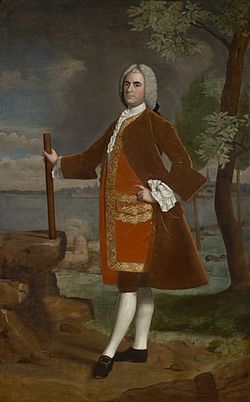Northeast Coast campaign (1747) facts for kids
Quick facts for kids Northeast Coast campaign (1747) |
|||||||
|---|---|---|---|---|---|---|---|
| Part of King George's War | |||||||
 Commander Samuel Waldo |
|||||||
|
|||||||
| Belligerents | |||||||
Wabanaki Confederacy |
|||||||
| Commanders and leaders | |||||||
| Commander Samuel Waldo (Falmouth) Captain Jonathan Williamson |
unknown | ||||||
| Strength | |||||||
| 625 | unknown | ||||||
| Casualties and losses | |||||||
| approximately 30 persons killed or captured | unknown | ||||||
The Northeast Coast campaign of 1747 was a series of attacks. It happened during King George's War. The Wabanaki Confederacy attacked English settlements. These settlements were along the coast of what is now Maine. The attacks took place from April to September 1747.
The Wabanaki Confederacy is a group of Native American nations. They attacked towns from Berwick to St. Georges. This area was once the border of Acadia. In just two months, there were 11 raids. Every town on the frontier was attacked. Casco, also known as Falmouth or Portland, was the main settlement.
Why the Campaign Happened
This campaign was part of a larger conflict. It was called King George's War. After two attacks on Annapolis Royal in 1744, the governor of Massachusetts, William Shirley, offered a reward. This reward was for capturing or killing members of the Passamaquoddy, Mi’kmaq, and Maliseet tribes.
The next year, in August 1745, Governor Shirley declared war. He declared war against the Penobscot and Kennebec tribes. These tribes were also part of the Wabanaki Confederacy.
New England forces had attacked and captured Louisbourg in June 1745. The Wabanaki Confederacy then fought back. They attacked the New England border settlements. New England prepared for these attacks. They sent 450 soldiers to defend the frontier. Later, they added 175 more soldiers.
Massachusetts also built forts along the border. These included Fort George at Brunswick. There was also St. George's Fort at Thomaston. Another was Fort Richmond at Richmond. Fort Frederick was built at Pemaquid. The 1747 campaign followed earlier attacks in 1745 and 1746.
Key Events of the Campaign
The Wabanaki Confederacy began their first raid on April 13. This attack was in Scarborough. Two people were killed, and four were taken prisoner.
On April 21, about 50 Native Americans raided Falmouth. They killed cattle. They also attacked Mr. Frost’s family. His wife and six children were taken captive. Twenty-six men, led by Captain IIsley, tried to catch them. But they could not find the attackers or the prisoners.
Captain Jordan’s company of 30 soldiers moved from Falmouth to Topsham. This left Falmouth without many defenders. The Native Americans then killed two women and one man in Falmouth. They crossed the Androscoggin River in a canoe. There, they killed two men and wounded a third. One woman managed to escape.
On May 26, 100 Native Americans attacked Fort Frederick at Pemaquid. They killed five soldiers and five new recruits. Other people living there were taken prisoner.
At Damariscotta, Native Americans took one person prisoner. They killed his wife and child.
At Wiscasset, Captain Jonathan Williamson was captured again.
In early September, a group of 60 Native Americans attacked Fort Frederick. They killed five guards. They then attacked the fort for two hours before leaving. At Fort Georges, Native Americans tried to dig a tunnel into the fort. They were not successful.
What Happened Next
In 1748, Frances Noble was taken captive near Fort Richmond. She later wrote a story about her experience.
Native Americans also killed several British people at Fort St. Georges in the fall of 1748.

